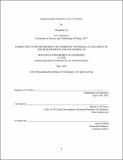| dc.description.abstract | The organometallic chemistry of Fe–S clusters has emerged as a new area in Fe–S enzyme biochemistry. In particular, alkylated [Fe₄S₄] clusters are now thought to be important intermediates in several classes of enzymes, including radical S-adenosyl-L-methionine (SAM) enzymes and enzymes involved in terpene biosynthesis. Due to the transient nature of these intermediates, full characterization of the geometric and electronic structures of enzymatic [Fe₄S₄]–alkyl species has not been possible. To address these challenges, we have synthesized a series of organometallic [Fe₄S₄] clusters to explore the electronic structures and reactivities of Fe–S clusters in the presence of the Fe–C bond. We first prepared novel 3:1 site-differentiated, alkylated or arylated [Fe₄S₄] clusters with chelating iminophosphorane ligands in various oxidation states. In-depth spectroscopic and computational analysis of these clusters suggests that alkylat-ed/arylated Fe sites exhibit partial or complete valence-localization in each redox state. By systematically tuning the donicities of the alkyl or aryl ligands, we demonstrated that the extent of valence localization and ground spin state is sensitive to the ligand-field strength. In addition to electronic structure studies, we also prepared alkylated [Fe₄S₄] clusters with 1,3-dimesitylimidazol-2-ylidene (IMes) ligands in several redox states and found that when the al-kylated Fe site has a coordination number greater than four, the Fe–C bond is dramatically weakened and undergoes rapid homolysis to releases alkyl radicals. In attempts to trap radical releasing intermediates, we discovered that the alkyl group would migrate from Fe on a [Fe₄S₄]³⁺ cluster to S and migrate back upon one-electron reduction. Overall, this thesis elucidates ligand-field effects on the electronic structures of [Fe₄S₄] clusters, addresses the intermediacy of organometallic intermediate radical SAM enzymes, and connects the organoiron and organosulfur chemistry. | |
